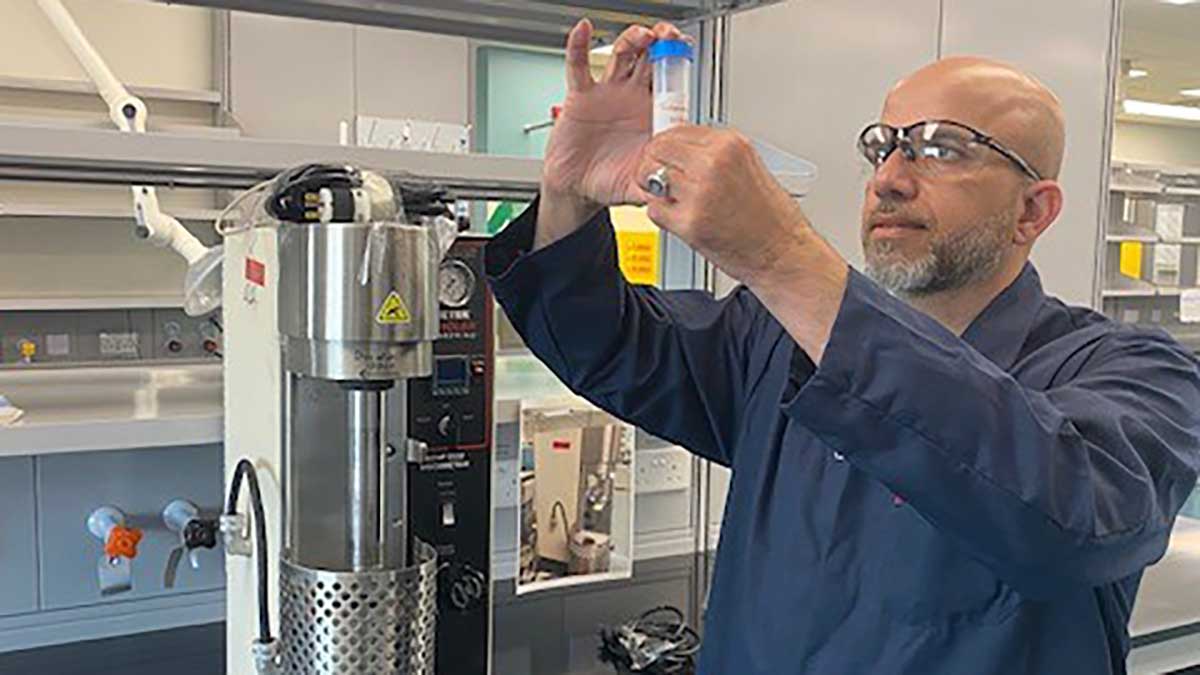Leveraging Technology
A new smart fluid solution: Nano-silica

Global January 16, 2022 - By
Saudi Aramco Technologies Company leverages our people’s creativity and innovation.
In many oil and gas fields around the world, one of the greatest challenges is the presence of excessive water and gas (sour gas) that seep into oil reservoirs’ production. Called water cut, this problem requires a great deal of time, money, and energy to separate out the water during oil production, while preventing harmful impacts to the environment.
At Aramco’s Exploration and Petroleum Engineering Center – Advanced Research Center (EXPEC ARC), a team of researchers has developed and patented a new smart fluid solution called nano-silica, which can be injected into wells, transformed into a gel, and can seal off porous sections of rock before water can seep in. It’s one of many new innovations that Aramco’s researchers are introducing in Aramco’s fields and commercializing for the industry, with the help of Aramco’s commercialization arm, the Saudi Aramco Technologies Company.
Now that nano-silica has been tested in the field and patented, it will be deployed on a larger scale in the field. By producing additional oil while reducing the production of water, we are showing our commitment to environmental sustainability. We are very proud of this technology
— Ashraf M. Al-Tahini, manager of Aramco’s EXPEC ARC
The problem it solves
The presence of excess water and sour gas in oil reservoirs has plagued oil operators for decades. Removing the water from the oil in oil processing plants is expensive, and then disposing of the produced water — which is often full of other noxious chemicals such as sulfur — presents an additional environmental challenge.
The hazards of produced water and gas, especially sour gas, include corrosion that can compromise upstream well and downstream systems, such as pipelines, gas-oil separation plants, and vessels. It is for these reasons, as well as the desire to protect the environment, that EXPEC ARC researcher Ayman M. Al Mohsin and his team began to look for solutions.
How it works
After much experimentation, the team came up with a novel cost-effective sealant that uses nanotechnology to block the near wellbore region. By targeting a highly porous or fractured rock structure downhole, drilling teams can inject a silane modified colloidal silica-based fluid system. Two separate solutions, one silica-based and the other an activator, are combined downhole, creating a gel that covers and rapidly seals a rock structure. This gel is designed for application in the high temperatures that are common in Saudi Arabia’s oil and gas fields.
“Water has a lower viscosity, so when it is under pressure, it will take the easy path to come toward the surface,” said Al Mohsin, inventor of the nano-silica solution. “Oil, on the other hand, is more viscous than water, so our idea was to use diagnostic tools to identify water cut and then inject solutions that can be mixed at the target zone.”
Al Mohsin, chief technologist Saad M. Al Mutairi, petroleum engineer Bader G. Al Harbi, and other scientists, engineers, and lab technicians in their team designed the materials to make use of their opposite charges that would cause them to collide with each other.
This technology is licensed to Nouryon Pulp & Performance Chemicals, a Swedish company for worldwide deployment.
Abbas S. Al Ghamdi, the CEO of Saudi Aramco Technologies Company commented: “Excess water production is a very serious problem that directly affects the economic life of a well. Our scientists have developed an elegant nano-silica-based in situ sealant technology with tunable gelation time, that plugs the fractures in the water producing zone. Successfully field tested and with plans for wider deployment via our commercialization partner Nouryon, we are quite excited about the promise this technology holds.”
Caption: Ayman M. Al Mohsin and his team of scientists invented a nano-silica technology to seal off porous sections of rock where water can seap in.



